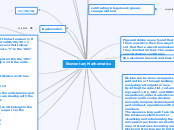Elementary Mathematics
Number line
subtracting integers using keep- change method
simplify fractions
common denominators (+/-)
Pigs and chickens, we found that there was more then five ways to find out that there was 18 animals and they counted 52 feet. The answer was 10 chickens and 9 pigs.
We also learn base 10 and base 5
Base 10 refers to the numbering system in common use that uses decimal numbers. Base 10 is also called the decimal system or denary system.
Division can be done as repeated subtraction or through building and analyzing rectangular arrays.
By letting the cube, flat, rod, and unit represent 1, 0.1, 0.01, and 0.001, respectively, older students can explore and develop decimal concepts, compare decimals, and perform basic operations with decimal numbers.
The squares along each face make the blocks excellent tools for visualizing and internalizing the concepts of perimeter and surface area of structures. Counting unit blocks in a structure can form the basis for understanding and finding volume.
A divisibility test is a rule for determining whether one whole number is divisible by another. It is a quick way to find factors of large numbers. Divisibility Test for 3: if the sum of the digits of a number is divisible by 3, then the number is divisible by 3.
Problem Solving Strategies
Move to base 5
multiplication in base 5
1208 / 26 = 46 R 12
46 / 26 = 1 R 20
Comparison -Diff models
11/15/16
whole numbers
Backwards C
11/15/16
Now, think about the last answer (1 R 20), it means that 1208/26/26 = 1 (plus bits), in other words it tells us that we should put a "1" in the "262" column
Next we should put a 20 in the "261" column, and lastly a 12 in the units.
Why?
Because our first division work has really said that:
1208 = 46 × 26 + 12
So, 12 belongs in the units column, and from here on we are dealing with the first power of 26:
46 = 1 × 26 + 20 (so 20 belongs in the ×26 column, and we put 1 in the ×26×26 column)
So the answer is:
262 261 1s
1 20 12
divison
integers and their arithmetic
Multiplication
fractions
fraction concepts and operations
Repeated subtraction
Base 10 Blocks
Upwards
Long/short

modeling integers: number lines
prime
